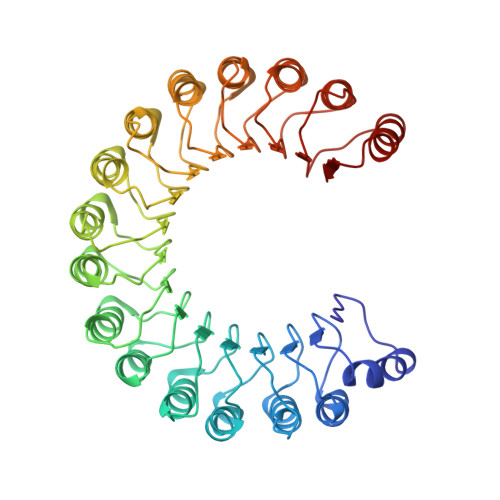Mechanism of ribonuclease inhibition by ribonuclease inhibitor protein based on the crystal structure of its complex with ribonuclease A.
Kobe, B., Deisenhofer, J.(1996) J Mol Biology 264: 1028-1043
- PubMed: 9000628
- DOI: https://doi.org/10.1006/jmbi.1996.0694
- Primary Citation of Related Structures:
2BNH - PubMed Abstract:
We describe the mechanism of ribonuclease inhibition by ribonuclease inhibitor, a protein built of leucine-rich repeats, based on the crystal structure of the complex between the inhibitor and ribonuclease A. The structure was determined by molecular replacement and refined to an Rcryst of 19.4% at 2.5 A resolution. Ribonuclease A binds to the concave region of the inhibitor protein comprising its parallel beta-sheet and loops. The inhibitor covers the ribonuclease active site and directly contacts several active-site residues. The inhibitor only partially mimics the RNase-nucleotide interaction and does not utilize the p1 phosphate-binding pocket of ribonuclease A, where a sulfate ion remains bound. The 2550 A2 of accessible surface area buried upon complex formation may be one of the major contributors to the extremely tight association (Ki = 5.9 x 10(-14) M). The interaction is predominantly electrostatic; there is a high chemical complementarity with 18 putative hydrogen bonds and salt links, but the shape complementarity is lower than in most other protein-protein complexes. Ribonuclease inhibitor changes its conformation upon complex formation; the conformational change is unusual in that it is a plastic reorganization of the entire structure without any obvious hinge and reflects the conformational flexibility of the structure of the inhibitor. There is a good agreement between the crystal structure and other biochemical studies of the interaction. The structure suggests that the conformational flexibility of RI and an unusually large contact area that compensates for a lower degree of complementarity may be the principal reasons for the ability of RI to potently inhibit diverse ribonucleases. However, the inhibition is lost with amphibian ribonucleases that have substituted most residues corresponding to inhibitor-binding residues in RNase A, and with bovine seminal ribonuclease that prevents inhibitor binding by forming a dimer.
- St. Vincent's Institute of Medical Research, Victoria, Australia.
Organizational Affiliation:
















